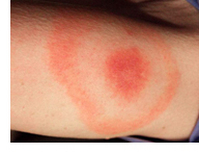Beginning of Lyme Disease
Lyme disease is a bacterial infection transmitted by a tick. Lyme disease was first recognized in 1975, after researchers investigated why unusually large numbers of children were being diagnosed with juvenile rheumatoid arthritis in Lyme, Conn., and two neighboring towns.
The investigators discovered that most of the affected children lived near wooded areas likely to harbor ticks. They also found that the children's first symptoms typically started in the summer months coinciding with the height of the tick season.
The investigators discovered that most of the affected children lived near wooded areas likely to harbor ticks. They also found that the children's first symptoms typically started in the summer months coinciding with the height of the tick season.
Several of the patients reported having a peculiar skin rash just before developing arthritis symptoms, and many also recalled being bitten by a tick at the rash site.
Further investigations resulted in the discovery that tiny deer ticks infected with a spiral-shaped bacterium or spirochete (which was later namedBorrelia burgdorferi) were responsible for the outbreak of arthritis in Lyme. Ordinary "wood ticks" and "dog ticks" do not carry the infection.
The ticks most commonly infected with B. burgdorferi usually feed and mate on deer during part of their life cycle. The recent growth of the deer population in the northeast and the building of suburban developments in rural areas where deer ticks are commonly found have probably contributed to the increasing number of people with the disease.
The number of reported cases of Lyme disease, as well as the number of geographic areas in which it is found, has been increasing. Lyme disease has been reported in nearly all states in this country, although most cases are concentrated in the coastal northeast, Mid-Atlantic States, Wisconsin, and Minnesota, and northern California. Lyme disease is also found in large areas of Asia and Europe. Recent reports suggest that it is present in South America, too.
Further investigations resulted in the discovery that tiny deer ticks infected with a spiral-shaped bacterium or spirochete (which was later namedBorrelia burgdorferi) were responsible for the outbreak of arthritis in Lyme. Ordinary "wood ticks" and "dog ticks" do not carry the infection.
The ticks most commonly infected with B. burgdorferi usually feed and mate on deer during part of their life cycle. The recent growth of the deer population in the northeast and the building of suburban developments in rural areas where deer ticks are commonly found have probably contributed to the increasing number of people with the disease.
The number of reported cases of Lyme disease, as well as the number of geographic areas in which it is found, has been increasing. Lyme disease has been reported in nearly all states in this country, although most cases are concentrated in the coastal northeast, Mid-Atlantic States, Wisconsin, and Minnesota, and northern California. Lyme disease is also found in large areas of Asia and Europe. Recent reports suggest that it is present in South America, too.

